City guides


Big Island Travel Guide
The youngest and largest of the Hawaiian Islands, the island of Hawaii (known as Big Island to avoid confusion) is one of the few places on earth where visitors can go from snowboarding to snorkelling in a single day! Local legend has it that the volcano goddess Pele and the demi-god Kamapua'a, who could control the weather, battled for the island and eventually decided to divide it: Pele took the hot, dry western half and Kamapua'a ended up with the wet, tropical east.
Big Island, however, actually has twelve distinct climatic zones ranging from tropical rain forests in the east to the frozen tundra atop Mauna Kea and the arid desert of Ka'u in the south. This diversity makes Hawaii's Big Island an unrivalled pleasure ground for active holidaymakers, the island's resorts offering every type of outdoor activity imaginable. To add to the thrill there is the attraction of two active volcanoes on this island. The Kilauea Caldera is the longest continuously erupting volcano in the world, its present eruptive phase dating back to 1983; Mauna Loa last erupted in 1984. Of the three other volcanoes on the island two, Mauna Kea and Kohala, are extinct, while Hualalai is considered to be dormant. All this volcanic action has meant that holidaymakers can decide on their preferred beach sand tones ranging from white to red, black and even green.
Together with the diverse ecosystems of Big Island is the rich Polynesian Hawaiian culture, a culture that has absorbed some interesting elements from both Asia and Europe, creating a colourful mix. On the coast visitors can dance the hula at an authentic luau feast, while upcountry they will find a blend of Portuguese and Mexican culture combined with Hawaiian tradition among the 'Paniolos' (cowboys) on the giant cattle ranches.
Things to do in Big Island
There's always plenty to see and do on Hawaii's biggest island. With no shortage of natural beauty, many holidaymakers spend the weekend to explore the breath-taking scenery in Volcanoes National Park, Waipi`o Valley, Akaka Falls, and the slopes of Mauna Kea. There are also several beautiful botanical gardens around Hilo.
The beaches of Big Island, while not as famous as Waikiki, are also worth seeing, as they are made up of more unusual black and green sand. Kua Bay is also a stunning white sand beach with good facilities.
Visitors who want to get up close and personal with nature can go on dolphin and whale-watching trips, and The Hilton Waikoloa Village offers a swimming with dolphins experience.
For a glimpse into life on Big Island, several coffee farms offer tours, as well as the Hawaiian Vanilla Company, the only vanilla farm in the US.
Lapakahi State Historical Park offers another perspective as a partially restored fishing village dating back 600 years. Pu'uhonua o Honaunau National Historical Park is also a must-visit to learn about Hawaiian heritage, though it is often crowded with tourists.
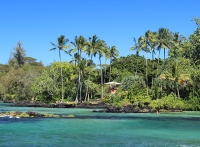
Hilo
Overlooking beautiful Hilo Bay and dominated by two volcanoes (the active Mauna Loa and dormant Mauna Kea), Hilo was a trading centre for native Hawaiians in ancient times, becoming an important port once the westerners had discovered that the area was ideal for growing sugar cane. More modern times have seen Hilo bear the brunt of two tsunamis, one in 1946 and another in 1960. But the hardy citizens of Hilo cleaned up their city after each affliction and now the high-water marks of these devastating events are a tourist attraction, along with the Pacific Tsunami Museum on the corner of Front and Kalakaua Streets. Although reminders of the past are everywhere in the architecture and attractions, Hilo remains a young city with a small-town feel, home to the University of Hawaii and the Merrie Monarch Festival, which celebrates hula dancing annually in the week after Easter. Another of the hottest happenings in Hilo is the Farmers' Market, held on Wednesdays and Saturdays along Front Street, when more than 100 vendors set up their stalls selling everything from fresh produce to Portuguese pastries and native crafts. The downtown area of Hilo contains Hawaii's largest collection of historic buildings, dating back to the turn of the century. There are plenty of restaurants, museums, a rainforest zoo and the beautiful Nani Mau Gardens to explore.
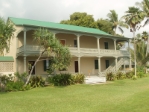
Hulihe'e Palace
The stately mansion of Hulihe'e is situated on Alii Drive in Kailua Kona on the west coast of Hawaii's Big Island. It was built in 1883 and served as the holiday home of Hawaiian royalty until 1925 when it was turned into a museum; it now houses a collection of ancient Hawaiian artefacts and personal memorabilia of the Hawaiian royal family. The bust of King Kalakaua's presides over the entrance hall, while the beautiful Koa dining table carved from a single log of wood graces the Kuhio Room. Little touches such as Princess Ruth's hatbox made from the trunk of a coconut tree and the cradle of Prince Albert, son of King Kamehameha IV, bring alive a sense of history in the house.
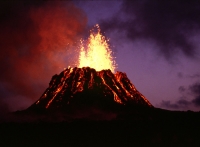
Hawaii Volcanoes National Park
In the Hawaii Volcanoes National Park surrounding the earth's largest volcano, Mauna Loa, visitors can actually watch lava flow into the sea from Kilauea, the still active on-site volcano. Park rangers direct visitors to the daily eruption activity on a dramatic burnt landscape, which transforms the landscape with the ongoing eruption. The park is located 30 miles (48km) southwest of Hilo on Highway 11, on the southeast coast of Big Island, and is a designated International Biosphere Reserve and UNESCO World Heritage Site.
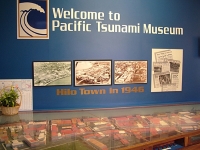
Pacific Tsunami Museum
Hilo has been destroyed several times by tsunamis. The first-hand oral testimony of tsunami survivors is now preserved along with some other fascinating information in the Pacific Tsunami Museum, located on Kamehameha Avenue in the town. The museum features a series of permanent exhibits that interpret the tsunami phenomena, the Pacific Tsunami Warning system, the history of tsunami in the Pacific Basin, tsunami of the future, myths, and legends about tsunami and public safety measures for tsunami disasters.
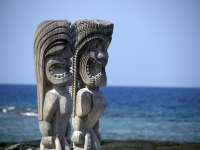
Pu'uhonua O Honaunau National Historical Park
This important Hawaiian cultural and historical site on the black-lava Kona Coast of the Big Island contains some forbidding-looking giant idols, although it was in fact built as a refuge for ancient Hawaiians who had violated kapu (social taboo) or as a sanctuary for defeated warriors. The surrounding area outside the huge enclosing wall was home to several generations of powerful chiefs. The 182-acre park also boasts other archaeological sites, including some temple platforms, royal fishponds and the ruins of ancient villages. The Hale o Keawe temple, which contains the mortal remains of 23 Hawaiian chiefs, and some thatched buildings have been reconstructed.

Kona Coffee Museum and Farm
For a taste of the coffee industry that flourished in the early 20th century on the Big Island, visitors can tour the Uchida Coffee Farm, south of Kealakekua town on the Kona Coast. Tour guides in period costumes show off the original farmhouse, bathhouse, coffee mill, and drying platforms. Only a few miles away is the Kona Historical Society Museum, housed in the old Greenwell family store, where photographs, ranching and coffee farming exhibits are on display. The store was built by Henry Greenwell in 1875.
United States of America travel info
Electricity
The electrical current is 120 volts, 60Hz. Plugs are mainly the type with two flat pins, though three-pin plugs (two flat parallel pins and a rounded pin) are also widely used. European appliances without dual-voltage capabilities will require an adapter.
Language
English is the most common language spoken but Spanish is often heard in the south-western states.
Money
The official currency is the US Dollar (USD), which is divided into 100 cents. Only major banks exchange foreign currency. ATMs are widespread and credit cards are widely accepted; Apple Pay and Google Pay are very popular. Banking hours are Monday to Friday 9am to 3pm.
Tipping
A 15 percent tip is expected by taxi drivers, bartenders, hairdressers and waiters, but travellers shouldn't tip in fast-food or self-service restaurants. In expensive restaurants or for large parties, the tip should be 20 percent of the bill. It's normal to tip staff such as valets and porters in hotels; this is discretionary, although a minimum of $5 is expected. Most services are customarily tipped if the service is good.
Health
There are no specific health risks associated with travel within the USA. Medical facilities are excellent, but expensive. Only emergencies are treated without prior payment and treatment can be refused without evidence of insurance or proof of funds. Good medical insurance is essential.
Safety
Travel within the United States is generally trouble-free, though travellers should be aware that the US shares with the rest of the world an increased threat from terrorist incidents. Security has been heightened, particularly at airports. Restrictions on hand luggage apply and travellers are advised to check on the latest situation with airlines in advance. Travellers should also be alert to the dangers of car and street crime in cities and should use common sense and take basic precautions. Hurricanes are common between June and November, putting the southern USA, including the Gulf Coast and the eastern US at risk. There's a risk of wildfires in many dry areas in the US, particularly on the West Coast from March to November.
Local customs
Laws vary from state to state, including speed limit, fines and punishment. The age at which alcohol may be legally bought and consumed is 21 years.
Doing business
In such a large country, filled with so many diverse groups, business practices may differ according to each state, though rarely to any large degree. The East Coast is traditionally more formal than the West Coast, though in states such as California, dress code and conservative appearance are as common as they would be in New York. Punctuality is important throughout the country and it's considered rude to be late for a meeting. Gift-giving is uncommon as it may be construed as bribery. Appropriate titles (Mr, Mrs, Ms) are used upon introduction and until otherwise stated. Americans favour politeness and greetings of 'Hello' and 'How are you?' are often expressed with sincerity. Business hours may vary in each state, but an 8am start and 5pm finish Monday to Friday is the most common with an hour over lunch.
Status and age are not necessarily indicative of seniority, nor do they carry much weight in themselves. Those doing business in the States should be mindful of this fact; foreigners should never make assumptions about someone's position or rank. Best practice is to be respectful to all parties. That said, the US upholds a hierarchal business structure in which 'the boss' is the ultimate decision-maker. Senior leaders have the power of the last word, and can go against the grain just as easily as they can follow popular opinion. Foreigners should concentrate on winning over this individual, even if the greater group seems unsupportive. Americans value a direct style of communication. In this fast-paced, consumer culture 'time is money', and small-talk is viewed as unnecessary and wasteful. It's best for foreigners to get to the point quickly, speak about issues in a frank and open manner, and to avoid taking offence if someone questions or challenges them outright.
Duty free
Travellers to the United States who are returning residents of the country do not have to pay duty on articles purchased abroad to the value of $800 provided their stay was longer than 48 hours and their duty-free allowance was not used in the 30-day period prior. For passengers arriving from Samoa, Guam and the U.S. Virgin Islands, a duty-free allowance of $1,600 is allowed. The following items are included in this: 50 cigarettes and 10 cigars and 150 millilitres (5 fl. oz.) of alcoholic beverages or 150 millilitres (5 fl. oz.) of perfume containing alcohol. Restrictions may apply to goods from Cuba, Iran, North Korea, Burma (Myanmar), Angola, Liberia and Sudan. It is prohibited to import Cuban cigars from any country.
Travellers to the United States who are non-residents do not have to pay duty on the following items: 50 cigars or 200 cigarettes and gifts to the value of $100 provided their stay in the USA is not less than 72 hours and that the allowance has not been used in the preceding six-month period.
Prohibited items for residents and non-residents include meat or meat products, poultry, narcotics, absinthe, plants, seeds, vegetables, fruits, soil, live insects and other living plants or animal pests. Fish is prohibited unless it carries disease-free certification. Wildlife and animals or their by-products carry restrictions. Dairy products and eggs from specified countries are not allowed. Firearms and ammunition are not allowed without the necessary license and permit.
Communications
The international country dialling code for the United States is +1. Mobile networks cover most of the country, especially all urban areas; travellers can purchase local prepaid SIM cards for unlocked phones or use eSIMs if their cellular providers support it on their networks. WiFi is widely available.
Passport & Visa
It is highly recommended that travellers' passports have at least six months' validity remaining after the intended date of departure from them travel destination. A visa is required for short visits unless travellers qualify for entry under the Visa Waiver Program.
The Visa Waiver Program (VWP) enables citizens of certain countries to travel to the US for a stay of up to 90 days without a visa. Visitors under the VWP need a valid Electronic System for Travel Authorization (ESTA), which allows the US government to screen all visitors before travel. Visitors entering the country under the VWP must have a machine-readable passport (MRP) that has a barcode on the photo page. Travellers under the VWP must have passports that include biometrics if they wish to enter the country without a visa, which means that passports must contain unique personal data such as fingerprints or iris details. All passports must contain a digital photo image in order to travel visa-free. All visitors to the USA have a photograph and two fingerprints taken by an inkless scanner on arrival, including those travelling visa-free under the VWP.
As part of the Western Hemisphere Travel Initiative (WHTI), all travellers travelling between the United States and Canada, Mexico, Bermuda, and the Caribbean region are required to present a passport or other valid travel document to enter or re-enter the United States. If departing from the USA, a valid passport is required by immigration authorities. Immigration officials often apply different rules to those stated by travel agents and official sources.
Entry requirements
US citizens require passports.
UK nationals require a passport valid for duration of stay. Most passport holders can get an Electronic System for Travel Authorisation (ESTA) through the Visa Waiver Programme, which allows travel to the US for up to 90 days. The VWP includes tourism, certain types of business visit and transit to another country.
The most important requirement on entering the U.S. is providing proof of Canadian citizenship. A valid Canadian passport is the best document to prove Canadian citizenship and the right to return to Canada. However, several other documents can serve, depending on the mode of transport. Generally, Canadian citizens do not require visitor, business, transit or other visas to enter the United States from Canada, though there are some exceptions.
Passports must be valid for the period of intended stay. If visiting the US for fewer than 90 days, Australian nationals may be eligible to apply for an Electronic System for Travel Authorization (ESTA), and enter under the Visa Waiver Program (VWP).
South Africans must hold a passport valid for duration of stay. A visa is required.
Passports must be valid for duration of stay. Irish nationals can get an Electronic System for Travel Authorisation (ESTA) under the Visa Waiver Programme for entry into the United States.
Passports must be valid for duration of stay. New Zealand nationals can get an Electronic System for Travel Authorisation (ESTA) under the Visa Waiver Programme for entry into the United States.
Useful contacts
United States Tourist Office: www.usatourist.com
911 (General)Embassies / consulates in other countries
United States Embassy, London, United Kingdom: +44 20 7499 9000.
United States Embassy, Ottawa, Canada: +1 613 688 5335.
United States Embassy, Canberra, Australia: +61 2 6214 5600.
United States Embassy, Pretoria, South Africa: +27 12 431 4000.
United States Embassy, Dublin, Ireland: +353 1 668 8777.
United States Embassy, Wellington, New Zealand: +64 4 462 6000.
Embassies / consulates in United States of America
British Embassy, Washington DC: +1 202 588 6500.
Canadian Embassy, Washington DC: +1 202 682 1740.
Australian Embassy, Washington DC: +1 202 797 3000.
South African Embassy, Washington DC: +1 202 232 4400.
Irish Embassy, Washington DC: +1 202 462 3939.
New Zealand Embassy, Washington DC: +1 202 328 4800.


